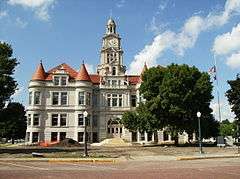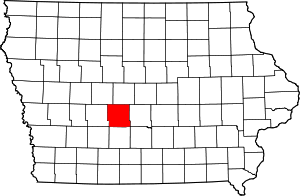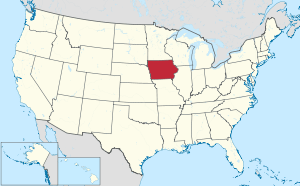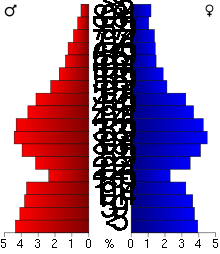Dallas County, Iowa
Dallas County is a county located in the U.S. state of Iowa. As of the 2010 Census, the population was 66,135.[1] Its county seat is Adel.[2] The county was named for George M. Dallas, Vice President of the United States under James K. Polk, the namesake of neighboring Polk County.
Dallas County | |
|---|---|
 | |
 Location within the U.S. state of Iowa | |
 Iowa's location within the U.S. | |
| Coordinates: 41°40′58″N 94°02′06″W | |
| Country | |
| State | |
| Founded | January 13, 1846 |
| Named for | George M. Dallas |
| Seat | Adel |
| Largest city | Waukee |
| Area | |
| • Total | 592 sq mi (1,530 km2) |
| • Land | 588 sq mi (1,520 km2) |
| • Water | 3.3 sq mi (9 km2) 0.5% |
| Population (2010) | |
| • Total | 66,135 |
| • Estimate (2018) | 90,180 |
| • Density | 110/sq mi (43/km2) |
| Time zone | UTC−6 (Central) |
| • Summer (DST) | UTC−5 (CDT) |
| Congressional district | 3rd |
Dallas County is included in the Des Moines–West Des Moines, IA Metropolitan Statistical Area.[3]
History
The land that now forms Dallas County was ceded by the Sac and Fox nation to the United States in a treaty signed on October 11, 1842.
On January 13, 1846, the legislative body of the Indiana Territory authorized creation of twelve counties in the Iowa Territory,[4] with general descriptions of their boundaries.[5] Dallas County's name referred to United States Vice President George M. Dallas, who served from 1845 to 1849.
In 1847 the county residents voted to designate Penoch as the county seat (the name was changed to Adel in 1849). The county's population grew rapidly, with settlers coming to claim homesteads. By 1870 the population had crossed the 12,000 mark.
Geography
According to the United States Census Bureau, the county has a total area of 592 square miles (1,530 km2), of which 588 square miles (1,520 km2) is land and 3.3 square miles (8.5 km2) (0.5%) is water.[6]
Major highways


.svg.png)





Adjacent counties
- Adair County – southwest
- Boone County – north
- Greene County – north and northwest
- Guthrie County – west
- Madison County – south
- Polk County – east
- Warren County – southeast
Demographics
| Historical population | |||
|---|---|---|---|
| Census | Pop. | %± | |
| 1850 | 854 | — | |
| 1860 | 5,244 | 514.1% | |
| 1870 | 12,019 | 129.2% | |
| 1880 | 18,746 | 56.0% | |
| 1890 | 20,479 | 9.2% | |
| 1900 | 23,058 | 12.6% | |
| 1910 | 23,628 | 2.5% | |
| 1920 | 25,120 | 6.3% | |
| 1930 | 25,493 | 1.5% | |
| 1940 | 24,649 | −3.3% | |
| 1950 | 23,661 | −4.0% | |
| 1960 | 24,123 | 2.0% | |
| 1970 | 26,085 | 8.1% | |
| 1980 | 29,513 | 13.1% | |
| 1990 | 29,755 | 0.8% | |
| 2000 | 40,750 | 37.0% | |
| 2010 | 66,135 | 62.3% | |
| Est. 2018 | 90,180 | [8] | 36.4% |
| U.S. Decennial Census[9] 1790-1960[10] 1900-1990[11] 1990-2000[12] 2010-2018[1] | |||
2010 census
The 2010 census recorded a population of 66,135 in the county, with a population density of 112.7698/sq mi (43.5407/km2). There were 27,260 housing units, of which 25,240 were occupied.[13]
2000 census

As of the census[14] of 2000, there were 40,750 people, 15,584 households, and 11,173 families in the county. The population density was 70 people per square mile (27/km²). There were 16,529 housing units at an average density of 28 per square mile (11/km²). The racial makeup of the county was 94.75% White, 0.74% Black or African American, 0.15% Native American, 0.69% Asian, 0.04% Pacific Islander, 2.79% from other races, and 0.84% from two or more races. 5.40% of the population were Hispanic or Latino of any race.
Of the 15,584 households 37.20% had children under the age of 18 living with them, 60.60% were married couples living together, 8.00% had a female householder with no husband present, and 28.30% were non-families. 23.60% of households were one person and 8.20% were one person aged 65 or older. The average household size was 2.59 and the average family size was 3.08.
The age distribution was 28.20% under the age of 18, 6.90% from 18 to 24, 32.10% from 25 to 44, 21.60% from 45 to 64, and 11.10% 65 or older. The median age was 35 years. For every 100 females, there were 97.70 males. For every 100 females age 18 and over, there were 93.80 males.
The median household income was $48,528 and the median family income was $58,293. Males had a median income of $37,243 versus $27,026 for females. The per capita income for the county was $22,970. About 4.00% of families and 5.60% of the population were below the poverty line, including 6.10% of those under age 18 and 7.10% of those age 65 or over.
Communities
Cities
- ‡ partly in Polk County
Unincorporated communities
Townships
Population ranking
The population ranking of the following table is based on the 2010 census of Dallas County.[15]
† county seat
| Rank | City/Town/etc. | Municipal type | Population (2010 Census) |
|---|---|---|---|
| 1 | West Des Moines (mostly in Polk County) | City | 56,609 |
| 2 | Urbandale (partially in Polk County) | City | 39,463 |
| 3 | Clive (partially in Polk County) | City | 15,447 |
| 4 | Waukee | City | 13,790 |
| 5 | Grimes (mostly in Polk County) | City | 8,246 |
| 6 | Perry | City | 7,702 |
| 7 | † Adel | City | 3,682 |
| 8 | Dallas Center | City | 1,623 |
| 9 | Granger (partially in Polk County) | City | 1,244 |
| 10 | De Soto | City | 1,050 |
| 11 | Woodward | City | 1,024 |
| 12 | Van Meter | City | 1,016 |
| 13 | Redfield | City | 835 |
| 14 | Dexter | City | 611 |
| 15 | Minburn | City | 365 |
| 16 | Linden | City | 199 |
| 17 | Dawson | City | 131 |
| 18 | Bouton | City | 129 |
Politics
Prior to 1932, Dallas County was strongly Republican in presidential elections. From 1932 to 1996, it was a swing county, having a Republican lean until 1960 & a Democratic lean from 1964 to 1996, especially after 1980. Since 2000, it has been consistently Republican, though no Republican Presidential candidate has won over 60% of the vote nor has a Democrat not won less than 40% since then.
| Year | Republican | Democratic | Third Parties |
|---|---|---|---|
| 2016 | 50.6% 19,339 | 41.1% 15,701 | 8.4% 3,212 |
| 2012 | 55.1% 20,988 | 43.5% 16,576 | 1.5% 552 |
| 2008 | 51.9% 16,954 | 46.4% 15,149 | 1.7% 540 |
| 2004 | 57.8% 15,183 | 41.5% 10,917 | 0.7% 193 |
| 2000 | 53.3% 10,306 | 44.3% 8,561 | 2.4% 463 |
| 1996 | 41.5% 6,647 | 50.1% 8,017 | 8.4% 1,346 |
| 1992 | 37.6% 5,587 | 44.1% 6,554 | 18.3% 2,720 |
| 1988 | 39.1% 4,858 | 60.4% 7,501 | 0.5% 60 |
| 1984 | 47.9% 6,080 | 51.7% 6,564 | 0.5% 63 |
| 1980 | 48.6% 6,296 | 41.0% 5,310 | 10.5% 1,358 |
| 1976 | 43.3% 5,308 | 54.9% 6,722 | 1.8% 217 |
| 1972 | 53.7% 6,143 | 44.5% 5,085 | 1.8% 208 |
| 1968 | 49.2% 5,549 | 44.9% 5,062 | 6.0% 676 |
| 1964 | 33.4% 3,763 | 66.1% 7,447 | 0.5% 52 |
| 1960 | 53.9% 6,566 | 46.0% 5,597 | 0.1% 13 |
| 1956 | 56.1% 6,619 | 43.9% 5,185 | 0.0% 2 |
| 1952 | 63.5% 8,008 | 35.7% 4,501 | 0.8% 101 |
| 1948 | 44.5% 4,810 | 52.3% 5,661 | 3.2% 348 |
| 1944 | 49.8% 5,413 | 48.9% 5,316 | 1.2% 135 |
| 1940 | 49.2% 6,218 | 49.7% 6,279 | 1.0% 131 |
| 1936 | 45.5% 5,442 | 53.0% 6,341 | 1.6% 190 |
| 1932 | 47.0% 4,516 | 50.9% 4,887 | 2.2% 208 |
| 1928 | 69.7% 7,294 | 29.7% 3,108 | 0.6% 58 |
| 1924 | 62.0% 6,359 | 9.1% 933 | 28.9% 2,969 |
| 1920 | 70.6% 6,677 | 27.3% 2,577 | 2.1% 200 |
| 1916 | 52.4% 2,900 | 45.1% 2,495 | 2.6% 143 |
| 1912 | 34.8% 1,825 | 32.7% 1,718 | 32.5% 1,706 |
| 1908 | 59.9% 3,132 | 35.8% 1,871 | 4.3% 222 |
| 1904 | 70.0% 3,499 | 23.2% 1,159 | 6.8% 341 |
| 1900 | 62.4% 3,601 | 33.6% 1,940 | 4.1% 234 |
| 1896 | 57.9% 3,326 | 40.3% 2,316 | 1.8% 105 |
See also
References
- "State & County QuickFacts". United States Census Bureau. Archived from the original on June 7, 2011. Retrieved July 16, 2014.
- "Find a County". National Association of Counties. Archived from the original on May 31, 2011. Retrieved June 7, 2011.
- United States Office of Management and Budget. "Update of Statistical Area Definitions and Guidance on Their Uses" (PDF). pp. 5, 36. Archived from the original (PDF) on May 14, 2006. Retrieved July 21, 2006.
- The counties were Boone, Clarke, Dallas, Decatur, Jasper, Lucas, Madison, Marshall, Polk, Story, Warren, and Wayne.
- The History of Polk County, Iowa: Containing a History of the County, Its Cities, Towns, &c. Union Historical Co. 1880. pp. 419, 425.
- "US Gazetteer files: 2010, 2000, and 1990". US Census Bureau. February 12, 2011. Retrieved April 23, 2011.
- Dallas County, Iowa Google Maps (accessed 20 August 2018)
- "Population and Housing Unit Estimates". Retrieved June 15, 2019.
- "U.S. Decennial Census". United States Census Bureau. Retrieved July 16, 2014.
- "Historical Census Browser". University of Virginia Library. Retrieved July 16, 2014.
- "Population of Counties by Decennial Census: 1900 to 1990". US Census Bureau. Retrieved July 16, 2014.
- "Census 2000 PHC-T-4. Ranking Tables for Counties: 1990 and 2000" (PDF). US Census Bureau. Retrieved July 16, 2014.
- "Population & Housing Occupancy Status 2010". US Census Bureau – American FactFinder. Retrieved May 7, 2011.
- "U.S. Census website". US Census Bureau. Retrieved January 31, 2008.
- "2010 Census". Retrieved February 13, 2016.
- Leip, David. "Dave Leip's Atlas of U.S. Presidential Elections". uselectionatlas.org. Retrieved April 25, 2018.
